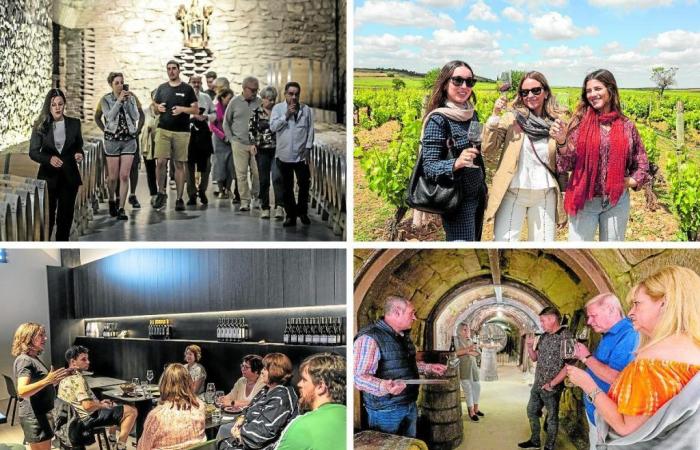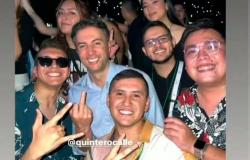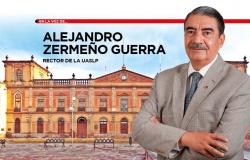Wine tourism is on the rise in the Qualified Denomination of Origin (DOCa) Rioja. It is now an activity fully integrated into the day-to-day life of wineries and there are more and more wineries that develop it successfully and with a high turnover. … which contributes significantly to your income statement. Diario LA RIOJA has reviewed the opinion of four representative wineries: Franco Españolas in Logroño, Lecea in San Asensio, Tritium in Cenicero and La Bodega del Tesoro in Cuzcurrita de Río Tirón.
Franco-Spanish Wineries Logrono
Hemingway, Alfonso XIII and Marcos Eguizábal, names of a successful model
A group of visitors tours, among barrels, the room of the Virgin in the facilities of Bodegas Franco-Españolas.
JUSTO RODRIGUEZ
The year 2023 was also a record year for wine tourism in Franco-Spanish. A total of 64,938 people visited the facilities of this winery located a five-minute walk from the center of Logroño, “which for us is an incomparable competitive advantage,” highlights Elena Pilo, director of wine tourism, a business area within the company and which contributes 10% to the income statement. “By 2024 it is expected that (this activity) will generate 1.6 million euros and a third of the income will come from the sale of wine,” she adds proudly.
Since 2009, wine tourism has been developed professionally, but you have to go back much further to “have foreign visitors” and also to have renown. Pilo refers to two illustrious presences in a winery that has already accumulated 134 years of history, the oldest in Logroño. King Alfonso Diamante, Royal and Rioja Bordón were the wines that the American writer and journalist is said to have tasted.
“They were our first wine tourists,” confirms Pilo, who introduces a third name when the winery opens to the public: Marcos Eguizábal. “When he bought the winery – in 1984 – he always opted to communicate the wine more closely.” And that continues to be the main objective of the company and, specifically, of the wine tourism department since they host massive cultural events such as the MUWI or Actual festivals.
60,000 meters underground
The visitor who tours Franco-Spanish completes the natural journey that the grapes make when they arrive at the winery. You know the tread, you can touch the original century-old vats and that is where the wine once fermented. The wine tourism route continues through the Virgen, Trasiega or Diamante rooms, where two of the legendary wines are located: Bordón and Diamante. The wine rack is another historical gem, although what really draws attention is in the basement. “When you come to the winery over the Iron Bridge, you don’t expect that you will find 60,000 meters underground” that run from that bridge to the Piedra bridge, explains the head of wine tourism.
Pilo demands from the general management of the wineries a “decided, real and with economic resources” commitment to an activity that “still has no ceiling.” But he also recognizes that growth can have a limit “when a destination hits its ceiling.” This is not yet the case of the Rioja Denomination because it also entered wine tourism “later than other regions.” Once that moment arrives, “we will have to be able to reinvent ourselves to continue capturing the attention of an increasingly demanding audience.”
Lecea Wineries San Asensio
50% of its sales, directly in the winery
Three young people from Madrid toast during their walk through the Lecea vineyards.
SONIA THIRD
Fifteen years in 2024 will mark the first crushing of the grapes to make Corazón de Lago, the carbonic maceration wine that has become an icon in Lecea. Then, in 2009, wine tourism began to develop in this family winery whose fifth generation continues with the philosophy of preserving tradition, but with new projects such as a ‘wine bar’ with a terrace or with a sixth cellar that, like the others that have been acquiring, they are also going to restore. Because the recovery of this underground heritage – fourteen meters below ground – from the 16th century “is one of our hallmarks,” highlights Estela Lecea, head of wine tourism.
In this winery “we have understood the need and importance of making our product known” and they offer various activities such as walks among vineyards with electric bicycles aboard classic 4×4 convertible cars. “We try to generate fun and novel experiences among our clients, it is a good way to build loyalty and make ourselves known to them,” adds one of Luis Alberto Lecea’s daughters who, together with her brothers Pablo and Lidia, is in charge of the company.
Last year, this winery in San Asensio received around 12,000 visits, which “is the first to appear recommended on Tripadvisor,” an American website specialized in travel. For this reason, the English-speaking market is the main source of visitors to Bodegas Lecea “and we are increasingly receiving more North Americans and British but also more South Africans and Australians.”
The impact of wine tourism for this family is such that “50% of our sales are made directly at the winery.” But they want to continue growing, but to do so “unity of action is needed among all Rioja agents,” concludes Estela Lecea.
From receiving tourists in the garage to selling wine in clay amphorae
The guide Itziar Calleja explains the tasting to some North Americans at the Tritium wine bar.
J. RODRIGUEZ
A 15th century winery with a depth of 200 meters and vineyards that are more than 90 years old are “some of our main charms” at Bodegas Tritium, highlights Francis Rubio, who together with his partner Javier Fernández lead this project “closely linked to wine tourism.” . They have been carrying out this activity professionally for about eight years, “but we have been practicing it for much longer,” he recalls, “when we received foreign clients, suppliers and distributors.” Then, the attention was in a garage “but we already opened our doors to the public.”
Now these visits have become professionalized “and we understand wine tourism as an important part of our business”, which generates approximately half of Tritium’s sales. “And we are on a street that is barely 2.5 meters wide and Cenicero, tourist-wise, is not Laguardia or Haro,” confesses Rubio. But his winery has been growing with attractions such as the production of part of its wines in clay amphorae, thus closing the circle given that the grapes come from an area (Tricio, whose Roman place name was Tritium) where ceramics were a common material.
Some of these amphorae rest in the winery and others are deposited in the Mediterranean Sea to age for eleven months at the bottom of the Tarragona coast. “We sell the wine in small amphorae, they are clay bottles of three quarters of a liter but glazed on the inside,” explains Francis Rubio.
Differentiation has to be “our hallmark, we have to focus on exclusive things,” he adds. And in this sense they are already working on new projects such as another cellar adjacent to the winery, the restoration of which has been entrusted to the renowned Catalan interior designer and designer Francesc Rifé. “We want to expand facilities to offer the best possible attention to visitors,” he concludes.
The Treasure Cellar Cuzcurrita from the Tirón River
Eat in wooden winepresses and with wines from different winemakers
Cámara explains the characteristics of a wine to some British tourists.
SONIA THIRD
“I sell tourism, I don’t sell wine.” The phrase corresponds to José Ramón Cámara, who is in charge, together with his wife Yosune de Francisco, of La Bodega del Tesoro, in Cuzcurrita, where wine is not made either but they do have references from some distinguished winemakers “who make us exclusive bottles.” , like Juan Carlos Sancha, Abel Mendoza or Pilar Fernández Eguíluz.
Cámara opted for this unique concept of tourism and wine seven years ago and “from the first moment I have wanted to differentiate myself and offer different things, because whoever likes this world of wineries and comes to Rioja has surely gone through France or Italy before.” or through Chile, Argentina or Napa Valley.
It refers mainly to foreign tourists, its almost exclusive client. His professional career organizing trips with foreigners supports him “and since seven years ago we decided to start La Bodega del Tesoro we have been clear about what we wanted to offer and who we wanted to target.”
Tradition is the differentiating element of its proposal “and for this what better than to offer the customer some potatoes with chorizo and some chops and the possibility of eating in wooden winepresses.” It is one of the ‘treasures’ that this winery has that dates back to 1881 but it was in 2017 when Cámara acquired it. “It had been closed for thirty years but it still had its charm,” he recalls. A historic draft, the large original wooden vats where the wines were made… Winemaking tradition in its purest form.
José Ramón Cámara wants his winery, with a wine bar and wine bar that is open on weekends and summer, to also serve as a way for small producers to make themselves known. “Because in Rioja there is room for everyone, but some need more help than others,” he says. The commitment to quality “has to be a priority for all of us who are within this Designation of Origin.”






